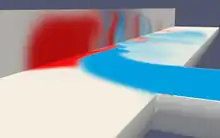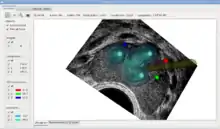 Multicomponent flow simulation | |
| Developer(s) | Avtech Scientific |
|---|---|
| Initial release | 14 May 2015 |
| Stable release | 0.1.7
/ 9 November 2016 |
| Repository | github |
| Written in | C++ |
| Operating system | Unix/Linux, Windows, Mac |
| Type | Multiphysics, Computer-aided engineering, Computational fluid dynamics, Simulation software |
| License | GNU Affero General Public License, optional commercial license (based on MIT License) |
| Website | asl |


_method.png.webp)


Advanced Simulation Library (ASL) is a free and open-source hardware-accelerated multiphysics simulation platform. It enables users to write customized numerical solvers in C++ and deploy them on a variety of massively parallel architectures, ranging from inexpensive FPGAs, DSPs and GPUs[1] up to heterogeneous clusters and supercomputers. Its internal computational engine is written in OpenCL and utilizes matrix-free solution techniques. ASL implements variety of modern numerical methods, i.a. level-set method, lattice Boltzmann, immersed boundary. The mesh-free, immersed boundary approach allows users to move from CAD directly to simulation, reducing pre-processing efforts and number of potential errors. ASL can be used to model various coupled physical and chemical phenomena, especially in the field of computational fluid dynamics. It is distributed under the free GNU Affero General Public License with an optional commercial license (which is based on the permissive MIT License).
History
Advanced Simulation Library is being developed by Avtech Scientific, an Israeli company. Its source code was released to the community on 14 May 2015, whose members packaged it for scientific sections of all major Linux distributions shortly thereafter.[2][3][4][5][6][7] Subsequently, Khronos Group acknowledged the significance of ASL and listed it on its website among OpenCL-based resources.[8]
Application areas
Advantages and disadvantages
Advantages
- C++ API[9] (no OpenCL knowledge required)
- Mesh-free, immersed boundary approach allows users to move from CAD directly to computations reducing pre-processing effort
- Dynamic compilation enables an additional layer of optimization at run-time (i.e. for a specific parameters set the application was provided with)
- Automatic hardware acceleration and parallelization of applications
- Deployment of same program on a variety of parallel architectures - GPU, APU, FPGA, DSP, multicore CPUs
- Ability to deal with complex boundaries
- Ability to incorporate microscopic interactions
- Availability of the source code
Disadvantages
- Absence of detailed documentation (besides the Developer Guide generated from the source code comments)
- Not all OpenCL drivers are mature enough for the library[10]
Features
ASL provides a range of features to solve number of problems - from complex fluid flows involving chemical reactions, turbulence and heat transfer, to solid mechanics and elasticity.[11]
- Interfacing: VTK/ParaView, MATLAB (export).
- import file formats: .stl .vtp .vtk .vti .mnc .dcm
- export file formats: .vti .mat
- Geometry:
- flexible and complex geometry using simple rectangular grid
- mesh-free, immersed boundary approach
- generation and manipulation of geometric primitives
- Implemented phenomena:
- Transport processes
- multicomponent transport processes
- compressible and incompressible fluid flow
- Chemical reactions
- electrode reactions
- Elasticity
- homogeneous isotropic elasticity
- homogeneous isotropic poroelasticity
- Interface tracking
- evolution of an interface
- evolution of an interface with crystallographic kinetics
- Transport processes
Uses
References
- ↑ "ASL - expanding software ecosystem for the DSP/FPGA/GPU market" (PDF). Archived from the original (PDF) on 25 August 2017. Retrieved 27 September 2015.
- ↑ "ASL - ASL enters Linux distributions at a record-breaking pace". asl.org.il.
- ↑ "Advanced Simulation Library". openSUSE Build Service.
- ↑ "Debian -- Details of package libasl0 in sid". packages.debian.org.
- ↑ "asl « sci-libs - proj/sci.git - Gentoo Science Overlay". cgit.gentoo.org.
- ↑ "ASL for Fedora". Archived from the original on 8 December 2015. Retrieved 30 November 2015.
- ↑ "Arch Linux - Package Search". archlinux.org.
- ↑ "OpenCL - The Open Standard for Parallel Programming of Heterogeneous Systems". The Khronos Group. 21 July 2013. Archived from the original on 8 October 2021. Retrieved 8 October 2021.
- ↑ "ASL: locomotive.cc". asl.org.il.
- ↑ "Deployment · AvtechScientific/ASL Wiki". GitHub. 25 July 2022.
- ↑ Scientific, Avtech (3 September 2015). "Advanced Simulation Library: Expanding software ecosystem for the DSP/FPGA/GPU market" – via hgpu.org.
{{cite journal}}: Cite journal requires|journal=(help) - ↑ "Results - Intraoperative Brain Shift | The Active Project". www.active-fp7.eu.
- ↑ "ASL assists neurosurgeons and robots, computes brain deformation in real time - Technology OrgTechnology Org". 14 September 2015.
- ↑ "ASL Software Assists Neurosurgeons and Robots". interestingengineering.com. 28 November 2016.